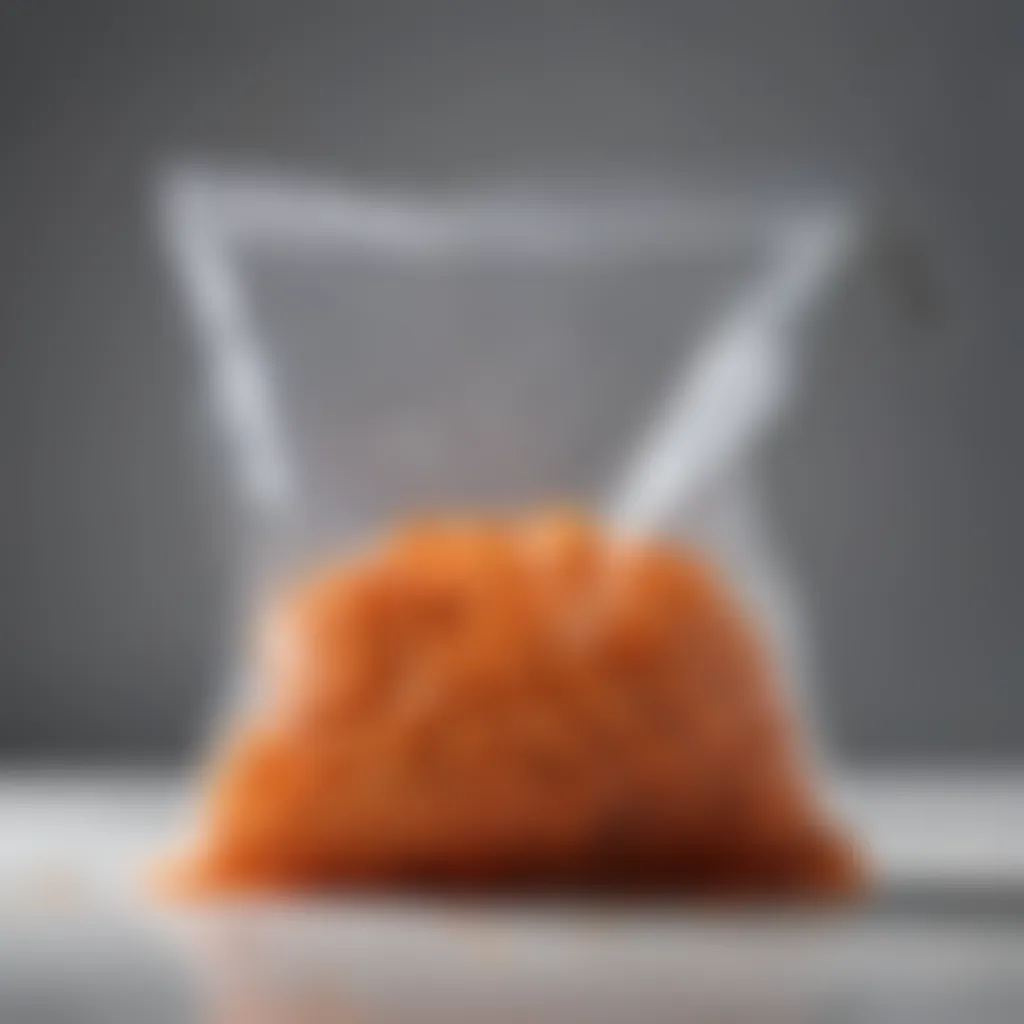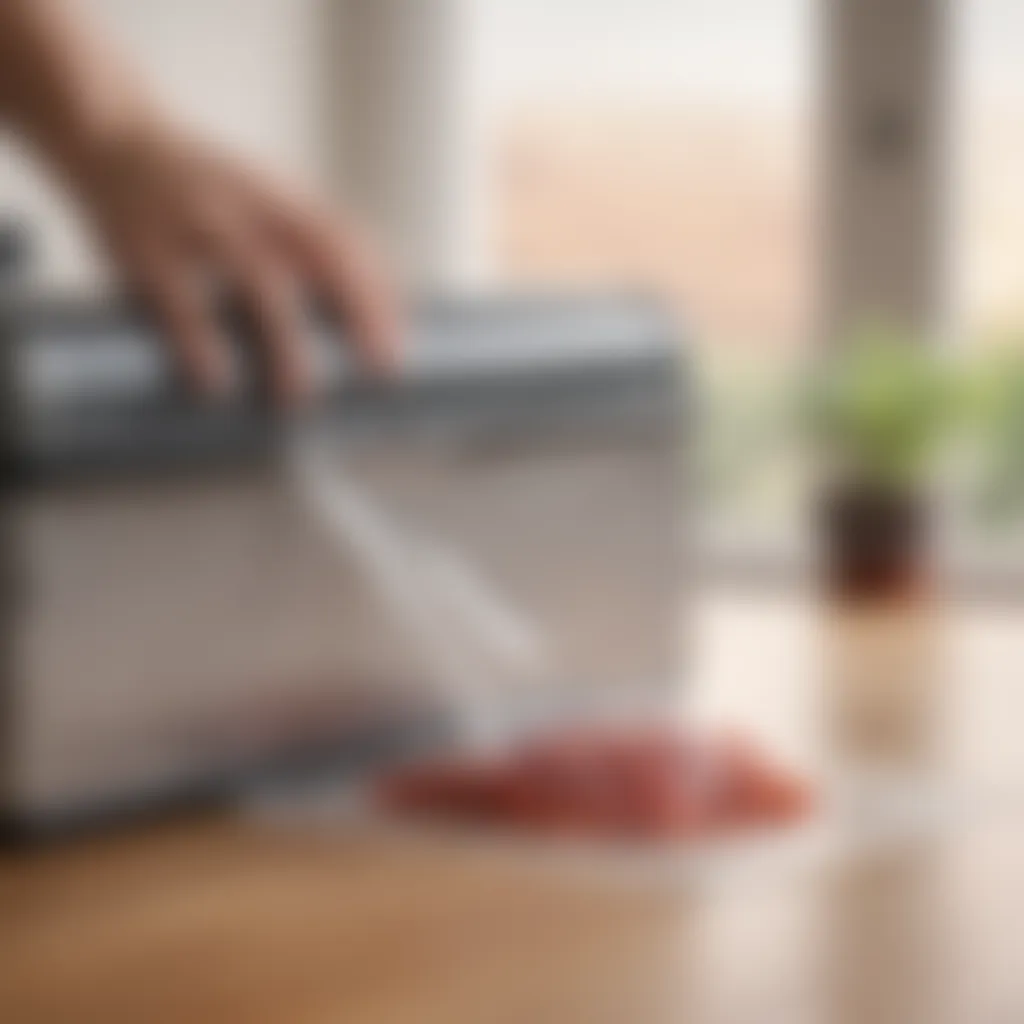Explore Top Inexpensive Vacuum Sealers for Smart Savings


Intro
Vacuum sealers have gained popularity in recent years, particularly for those keen on food preservation and cooking efficiency. Understanding the nuances and functionalities of inexpensive vacuum sealers can make a significant difference in your kitchen routines. Choosing the right model can help you save money while ensuring your food stays fresh and flavorful.
In this guide, we will explore various models available today, focusing on functionality, types, and the essential aspects that should guide your purchasing decisions. We aim to equip readers with the knowledge to select an ideal vacuum sealer without straining their budgets.
Ingredients:
When venturing into the world of vacuum sealing, preparing your food properly is crucial. Here’s a clear itemized list of potential cooking ingredients you may need:
- Fresh meat (1-2 pounds) - beef, chicken, or pork
- Vegetables (2-3 cups) - bell peppers, zucchini, or carrots
- Seasoning (to taste) - salt, pepper, garlic powder
- Olive oil (2 tablespoons)
- Herbs (1-2 teaspoons) - rosemary or thyme
Preparation Steps:
Detailed Instructions:
- Clean fruits and vegetables: Rinse them under cool water to remove dirt and contaminants.
- Cut ingredients: Slice vegetables into uniform pieces and portion meat as necessary.
- Season the food: Use olive oil, salt, and your choice of seasonings. Mix well to ensure even flavor distribution.
- Cool required preparation: If desired, marinate meat for at least 30 minutes for added flavor.
Technical Aspects:
Fishing out the specifications of your appliance can enhance efficiency. Pay attention to:
- Temperature settings: Most vacuum sealers operate at room temperature but be cautious of heat-sensitive items.
- Timing specifics: Ensure your seal is tight and monitor the time based on the model used. Typical sealing time ranges from 30 seconds to a minute.
- Critical techniques: For better results, pre-freezing liquids or soft foods can help establish a proper seal.
Cooking Process:
Follow these sequential steps for optimal results:
- Pre-heat your vacuum sealer based on your model’s instructions.
- Place the food in the sealing bag: Use the appropriate size for the quantity you prepared.
- Use the vacuum function: Ensure the bag is aligned properly for effective sealing.
- Seal the bag properly: Wait for the light to indicate a successful seal.
- Label the bags: Write down the contents and date before storing in the freezer or refrigerator.
Troubleshooting Tips:
Common mistakes can derail the vacuum sealing process. Here are solutions:
- If the seal doesn’t hold: Check for food particles in the sealing area. Ensure it's clean before sealing again.
- If there is air left in the bag: Reassess the alignment of the bag when using the vacuum feature.
- If bags are punctured: Choose thicker bags designed for vacuum sealing. Thin bags may not withstand pressure.
"Understanding how to use a vacuum sealer properly can elevate your food preservation game, saving both time and money."
By following these guides, you are now prepared to explore the various vacuum sealers available for purchase. In the subsequent sections, we will examine specific models that offer great value for their price, enabling you to make informed choices moving forward.
Prolusion to Vacuum Sealers
Understanding vacuum sealers is essential for anyone who seeks effective food preservation and organization solutions. These devices offer a distinct advantage in maintaining the freshness of food, minimizing spoilage, and extending shelf life. Additionally, vacuum sealing can save time and money in your kitchen by allowing bulk purchasing and storage of food items. In this section, we will explore the purpose and benefits of vacuum sealing, as well as delve into the historical context of this technology, which will enrich your comprehension of its relevance today.
Purpose and Benefits of Vacuum Sealing
Vacuum sealing serves multiple practical purposes. First and foremost, it helps in preventing air from coming into contact with food. This removal of air slows the growth of bacteria and mold, essential factors leading to food spoilage. Foods sealed properly can often last several times longer than those stored in traditional bags or containers.
Beyond food preservation, vacuum sealers are beneficial for meal prepping. By preparing meals in advance and vacuum sealing them, it becomes easier to grab a meal, heat it, and enjoy. This convenience can simplify busy lifestyles, especially for families.


Furthermore, vacuum sealing is adaptable. It is not just limited to meat or vegetables. You can seal various items, from snacks to liquids. Adding versatility to its usage increases its value in household management.
Historical Context of Vacuum Sealing Technology
The history of vacuum sealing is quite fascinating and reflects advances in food storage techniques. The process dates back to the 1940s when the need arose to keep food fresh during long-haul journeys, such as military expeditions. Initially, vacuum sealing was implemented primarily in industrial settings.
As the technology evolved, it was adapted for home use by the late 20th century, making it accessible to everyday consumers. The introduction of external and chamber vacuum sealers in homes changed the way people approached food storage. A growing awareness of food waste and preservation techniques led consumers to embrace this method as a viable solution.
Today, vacuum sealers, such as those produced by FoodSaver and VacMaster, are commonplace in kitchens. They are not just tools but rather an essential part of a modern, efficient cooking practice. Understanding this background allows us to appreciate why so many people rely on vacuum sealers for both food storage and meal preparation.
Understanding Vacuum Sealers
Understanding vacuum sealers is a vital aspect of acquiring the appropriate tool for preserving food and maximizing storage efficiency. Vacuum sealers operate on a straightforward principle: they remove air from bags before sealing them, which helps to slow down spoilage and maintain freshness. Knowing how these devices function and their various types enables consumers to select the right option to suit their needs.
The significance of understanding vacuum sealers lies not only in the technology itself but also in the myriad of benefits these devices offer. For instance, vacuum sealers empower homemakers to extend the shelf life of perishable goods significantly. This leads to reduced food waste, an important consideration for both economic and environmental sustainability. Further, understanding the differences among types of vacuum sealers also ensures that the choices made are well-informed, ultimately resulting in a satisfying user experience.
Mechanism of Action
The mechanism of action behind vacuum sealers is relatively direct. At its core, a vacuum sealer creates an airtight environment by utilizing suction to remove the air from specially designed bags or containers. This process eliminates the oxygen present in the package, which is a primary factor in food spoilage.
Once the air is removed, the vacuum sealer then heats up and seals the bag by melting the edges together to create a tight closure. This two-step action ensures that the food inside the package remains preserved for an extended period. Additionally, a vacuum's reduction of exposure to air helps to prevent freezer burn, which can drastically affect the quality of frozen items.
Types of Vacuum Sealers
When considering vacuum sealers, it is crucial to understand the different types available on the market and their unique characteristics. Each type has its advantages and limitations, making them suitable for varying needs and budgets.
External Vacuum Sealers
External vacuum sealers are among the most common types found in households. They work by placing a bag filled with food into a slot in the machine, which then sucks out the air and seals the bag. The key characteristic of external vacuum sealers is their accessibility and variety. Affordable models can be found easily, making them a popular choice for most users.
The unique feature of external vacuum sealers is their portablity, as they are lightweight and require minimal counter space. However, they may not seal liquids as effectively as other types, which can be a disadvantage for certain applications.
Chamber Vacuum Sealers
Chamber vacuum sealers are designed for larger quantities and more demanding tasks. In this type, the entire bag is placed inside a chamber, which removes the air from both the bag and the chamber itself. This design highlights chamber vacuum sealers as being particularly effective in preventing air pockets and sealing liquids without spillage.
While they are generally more expensive, their ability to handle larger jobs and liquids makes them a beneficial option for those who regularly preserve meals or bulk items. The disadvantage is that they can take up more space in the kitchen and may require more investment.
Handheld Vacuum Sealers
Handheld vacuum sealers are versatile and convenient options for quick tasks. These devices are used manually and can seal bags on the go, providing the flexibility to work with different-sized bags. The key characteristic of handheld sealers is their portability and ease of use, which makes them a good choice for those who do light sealing tasks and do not need heavy-duty equipment.
A unique feature of handheld vacuum sealers is their ability to be used independently from larger machines, which saves counter space. However, their effectiveness may be limited for large-scale vacuum sealing, and they might not provide a tight seal as chamber models.
Understanding each type of vacuum sealer enables consumers to select a device that matches their specific needs, making for an informed investment.
Key Considerations for Choosing a Vacuum Sealer
When selecting a vacuum sealer, there are critical factors that warrant careful evaluation. These considerations will determine not only the viability of the appliance but also its alignment with individual needs. Understanding these aspects helps in making informed choices that ultimately lead to cost-effective and functional results.
Budget Constraints vs. Features


The interplay between budget constraints and features is perhaps the most daunting aspect for many consumers. While one may be tempted to choose the least expensive option, this does not always equate to long-term savings. Higher-priced models often offer additional features that can enhance user experience and performance. These may include specialized settings for different food types, enhanced sealing widths, or built-in cutters for bags.
On the contrary, opting for a cheaper model can lead to quicker breakdowns or lesser functionality. For instance, a model priced at $50 may not handle liquids effectively, whereas a $100 alternative designed with that capability could save on wasted food and reduce spoilage. It is prudent to establish a budget while also identifying essential features that will meet specific needs. This ensures your purchase not only fits your wallet but also satisfies your requirements.
Durability and Material Quality
Durability and material quality are pivotal in the decision-making process. The construction of a vacuum sealer directly impacts its lifespan and performance. Models crafted from high-grade materials are more likely to withstand frequent usage without malfunctioning. Moreover, vacuum sealers that utilize robust components may offer better sealing capabilities, essential for maintaining food freshness over time.
Purchasing a vacuum sealer made of plastic shells can appear less expensive initially. However, over time, plastic may become brittle and may not perform effectively. It’s beneficial to look for models with stainless steel components which tend to last longer and offer better reliability. Ensuring that the model has good reviews regarding durability can assist in making a sound investment that will endure the test of time.
Ease of Use and Maintenance
The ease of use and maintenance is another significant consideration when selecting a vacuum sealer. Users want a vacuum sealer that operates smoothly without needing extensive training or frequent troubleshooting. Choose a model that has intuitive controls, clear labeling, and straightforward procedures for compression and sealing food.
Additionally, maintenance is often overlooked but can greatly affect the user experience. Models that require extensive cleaning or upkeep may become burdensome over time. Look for features such as removable drip trays or dishwasher-safe components that aid in hassle-free maintenance. Readiness in sealing food should not be obstructed by complicated cleaning processes. Thus, selecting a model that prioritizes user-friendliness will go hand in hand with comfort in regular use, cementing your appliance's place in your kitchen for years to come.
"Investing in a vacuum sealer is not merely about buying a machine; it's about selecting one that resonates with your operational rhythm and lifestyle."
By evaluating budget considerations, durability, and ease of use closely, readers can navigate the vacuum sealer market with confidence. Making educated decisions will ensure satisfaction in the long run.
Top Inexpensive Vacuum Sealers on the Market
When considering inexpensive vacuum sealers, it is essential to evaluate the various models available in the market. This section aims to provide a comprehensive overview of the leading vacuum sealers that are budget-friendly yet effective. The right vacuum sealer can enhance food preservation, reducing waste and saving money in the long term. Therefore, understanding the key models helps consumers make a wise investment.
Overview of Models
Model Comparisons
In comparison of various models, factors such as suction power, sealing time, and ease of use become pivotal. Different models cater to diverse needs. For instance, the FoodSaver V4840 is renowned for its dual-seal technology, which ensures better preservation compared to many others. It's known for reliability and consistent results. Moreover, the NutriChef PKVS18SL, although simpler, is user-friendly for people who are not tech-savvy. A clear comparison of these features illustrates how different models serve specific purposes.
The main appeal of a model comparison is to demystify the choices. By assessing aspects such as price, efficiency, and additional features, potential buyers can find a model that aligns with their specific needs. Products like the Geryon E2900 have good user reviews for vertical standing and compact design, which make it suitable for small kitchens, enriching the options for users.
User Ratings and Testimonials
User ratings and testimonials often reflect the real-world performance of vacuum sealers. These reviews inform future buyers about the practical aspects of using these devices. For example, the review for the Anova Precision Cooker shows users enjoy its ability to maintain vacuum without any fuss.
A notable aspect of this feedback is related to customer support and warranty services. Users appreciate brands that provide responsive assistance, enhancing their purchase experience. Inexpensive options often come under scrutiny when it comes to durability, and positive feedback can help mitigate concerns. Therefore, exploring ratings and testimonials creates a more holistic understanding of the models and their longevity.
Detailed Specifications
When selecting a vacuum sealer, scrutinizing the detailed specifications minimizes buyer remorse. Specification lists should include features like vacuum strength, bag compatibility, and built-in safety measures. For instance, the Weston Pro-2300 boasts a powerful motor capable of sealing large amounts of food quickly, making it a favorite among home chefs. On the other hand, compact options may have a lower wattage but still effectively preserve food.
Price Range Analysis
The price range for vacuum sealers varies significantly. One can find models starting around $30, while premium options can climb upwards of $600. However, the best inexpensive vacuum sealers typically fall within the $50 to $150 range. These products often balance quality with affordability. Consumers should not only focus on the cost but also the value they expect to gain, ensuring functionality exceeds the investment. In addition, seasonal sales and promotions can also provide opportunities to snag a deal on a vacuum sealer without compromising quality.
Practical Uses of Vacuum Sealers
Vacuum sealers serve more than just food preservation; they have numerous practical applications that can help simplify organization and save space. Understanding these uses can elevate your approach to both cooking and home management. This section explores the various practical uses of vacuum sealers, detailing their significance and benefits.


Food Preservation
Food preservation is perhaps the most recognized application of vacuum sealers. The process of removing air from bags before sealing helps extend the shelf life of perishable items. This method champions freshness, maintaining flavor and nutritional value better than conventional storage methods. Vacuum sealing reduces spoilage and waste, making it a financially savvy option for households.
When food is sealed in a vacuum, the growth of bacteria, mold, and yeast is significantly slowed down due to the absence of oxygen. This is especially beneficial for meats, cheeses, and even fruits and vegetables. For example, sealing meats can prevent freezer burn, which often ruins the texture and taste. Additionally, marinating food in vacuum seal bags speeds up the absorption of flavors, enhancing your culinary undertakings.
Non-food Applications
Although food preservation reigns supreme, vacuum sealers have noteworthy applications beyond the kitchen.
Storing Clothing
Storing clothing using vacuum sealers is a smart way to manage space, especially in smaller homes. Sealing clothes compresses the fabric, significantly reducing its volume. This is particularly useful for seasonal items like winter coats or summer apparel. When you remove air, it helps prevent musty odors, mildew, and pests, which can harm fabric.
One key characteristic of using vacuum sealers for clothing is that it keeps garments in pristine condition. However, users should be cautious. Not all materials do well with vacuum sealing. Delicate fabrics may deform or lose their structure if compressed too tightly. Therefore, understanding what types of clothing can be stored this way is critical for maintaining quality.
Organizing Household Items
Vacuum sealers also play a vital role in organizing various household items. From linens to toys, vacuum sealing can help organize items in a more efficient manner. When you vacuum seal bedding, for instance, you can easily fit multiple sets into a single space. This not only clears clutter but also creates a more visually appealing living area.
A unique feature of using vacuum sealers for organizing household items is versatility. These devices can handle multiple types of materials. However, a consideration is that not all household items should be stored this way. Items that require air circulation, such as certain leather goods, can suffer when vacuum sealed.
"Employing vacuum sealers for non-food items showcases their value in maintaining an organized and fresh home environment."
Common Issues and Solutions
Understanding potential issues that can arise with vacuum sealers is essential. Many users encounter challenges that can hinder their experience, ultimately affecting the efficiency of the device. Addressing these issues helps ensure optimal performance over time. Moreover, solutions can often save time and money, allowing users to maximize the benefits of their vacuum sealers.
Troubleshooting Vacuum Sealers
Troubleshooting is an important aspect of maintaining your vacuum sealer. Common problems include inadequate suction, sealing issues, and malfunctioning indicators. Here are a few strategies to address these problems:
- Inadequate Suction: First, check if the sealing strip is clean. Residue can impede proper sealing. Additionally, ensure there is no obstruction in the vacuum chamber that may prevent air from being effectively removed.
- Sealing Issues: If the seal is not secure, inspect the bags used. Low-quality or damaged bags may not work properly with your sealer. Ensure you are using compatible vacuum bags.
- Malfunctioning Indicators: If the indicator lights do not respond, it may be a power issue. Try unplugging the device for a moment and then reconnecting it. If problems persist, consult the user manual for troubleshooting steps specific to the brand.
Long-term Maintenance Tips
Long-term maintenance is crucial for the longevity of a vacuum sealer. Regular upkeep not only prevents issues but also enhances performance. Here are several tips to consider:
- Regular Cleaning: After each use, clean the sealing area and the vacuum chamber. This helps prevent build-up of food particles or moisture, which could affect functionality.
- Inspect Consumables: Check the condition of the bags and the sealing strip regularly. Replace them as needed to ensure consistent sealing performance.
- Store Properly: When not in use, store your vacuum sealer in a dry place, away from heat sources. This will help protect the device from environmental factors that could damage it.
- Follow Manufacturer's Guidelines: Each model may have specific maintenance recommendations. Always refer to the user manual provided by the manufacturer for the best practices.
Proper maintenance can extend the life of your vacuum sealer, allowing you to enjoy its benefits for years to come.
Culmination
The conclusion serves as a critical part of this discussion on inexpensive vacuum sealers. It allows readers to synthesize the information presented throughout the article and grasp the overall significance of choosing the right vacuum sealer for their needs. Understanding this choice ultimately impacts practical applications in food preservation, storage efficiency, and financial savings.
Final Thoughts on Inexpensive Vacuum Sealers
In summary, inexpensive vacuum sealers provide an accessible solution for anyone interested in maximizing food shelf-life and minimizing waste. These devices cater to users who seek value without compromising functionality. The various models discussed earlier demonstrate that cost-effective options do exist. They offer features that align well with everyday kitchen use, making them practical additions to household routines. Based on what we explored, understanding the differences in technology, usability, and maintenance can empower buyers to select a device that not only fits within their budget but meets their specific needs as well.
Encouragement for Informed Purchasing
When it comes to purchasing a vacuum sealer, it is essential to conduct thorough research. Take the time to compare models, read user reviews, and evaluate your personal requirements. Think about how often you plan to use the device, what types of food you wish to preserve, and the storage space available in your kitchen.
"Informed purchasing leads to greater satisfaction and efficiency in the long run."
Informed decisions result in a better fit for your household. This preparation reduces the likelihood of frustration with a product that may not meet expectations. Therefore, approach your potential purchase with clarity and confidence. By doing so, you ensure that your investment provides meaningful benefits for years to come.







